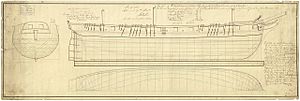HMS Carron (1813) facts for kids

Carron
|
|
Quick facts for kids History |
|
|---|---|
| Name | HMS Carron |
| Ordered | 18 November 1812 |
| Builder | Edward Adams, Bucklers Hard |
| Laid down | March 1813 |
| Launched | 9 November 1813 |
| Commissioned | 11 November 1813 |
| Fate | Wrecked 6 July 1820 |
| General characteristics | |
| Class and type | 20-gun Cyrus-class sixth-rate post ship |
| Tons burthen | 459 2⁄94 (bm) |
| Length |
|
| Beam | 29 ft 9+1⁄2 in (9.1 m) |
| Depth of hold | 8 ft 6+1⁄8 in (2.59 m) |
| Sail plan | Full-rigged ship |
| Complement | 135 |
| Armament |
|
HMS Carron was a warship of the Royal Navy, the navy of the United Kingdom. She was built in 1813 by Edward Adams in Bucklers Hard, England. Carron was a "post ship," which was a type of warship with 20 to 24 guns. She was part of the Cyrus-class of ships. Sadly, Carron was wrecked in 1820.
Contents
Life at Sea: Carron in Action
Carron began her service in January 1814. Her first captain was Robert Cavendish Spencer. He was the son of a very important person, George Spencer, who was the 2nd Earl Spencer.
Battles in the War of 1812
In July 1814, Carron was in Bermuda. She picked up a group of Royal Marines, who are special soldiers trained for sea and land. These marines were led by Edward Nicolls. Their mission was to go to the Gulf Coast of America.
They arrived at the Apalachicola River in August 1814. Carron then joined an attack on Fort Bowyer. This attack was not successful for the British. Another ship, Hermes, was lost during this battle.
For a few months, Carron stayed near Pensacola. But in November 1814, American forces led by General Andrew Jackson made the British leave.
Capturing Ships and Prize Money
After leaving Pensacola, Carron had some success. On November 29, she captured two enemy ships, the schooners Hirondelle and Dos Amigos. When a warship captured an enemy ship, the crew could get "prize money." This was money from selling the captured ship and its cargo. For Captain Spencer, this money was a lot! Even an ordinary sailor received a good amount, like half a year's pay.
Carron also shared in the prize money from the Battle of Lake Borgne. This battle happened in December 1814, just before the famous Battle of New Orleans. Captain Spencer was praised for finding a good spot for British soldiers to land. He also helped lead the naval group during another attack on Fort Bowyer in February 1815.
Changes in Command
In March 1815, Carron was near St Vincent Island. Captain Spencer was then given command of another ship, HMS Cydnus. This was a reward for his hard work in Louisiana and Florida.
Lieutenant James B. Tathnell briefly commanded Carron when Captain Spencer was away. After Spencer left, Captain Nicholas Pateshall took command from April 1815. Carron was then taken out of service in August 1816.
However, Carron was brought back into service in May 1818. Commander John Furneaux became her new captain. She was sent to serve in the East Indies, a region that included parts of Asia.
The End of Carron
On July 6, 1820, Carron was sailing south towards Madras, India. At 3 AM, she hit the ground, even though her crew thought they were far from the coast. She was only about a quarter of a mile from shore.
The crew tried very hard to free the ship, but it quickly filled with water. Her small boats were lost, and the ship broke apart. Many people made it safely to shore. However, 21 people were lost, including a lieutenant, the ship's master, and 19 crewmen.
Later, a special naval court investigated what happened. They decided that a strong, unexpected ocean current was to blame for the loss of Carron.
In March 1821, Commander John Furneaux and some of his officers and crew returned to England on another ship called Borodino. They had traveled all the way from Trincomalee, a port in Sri Lanka.

